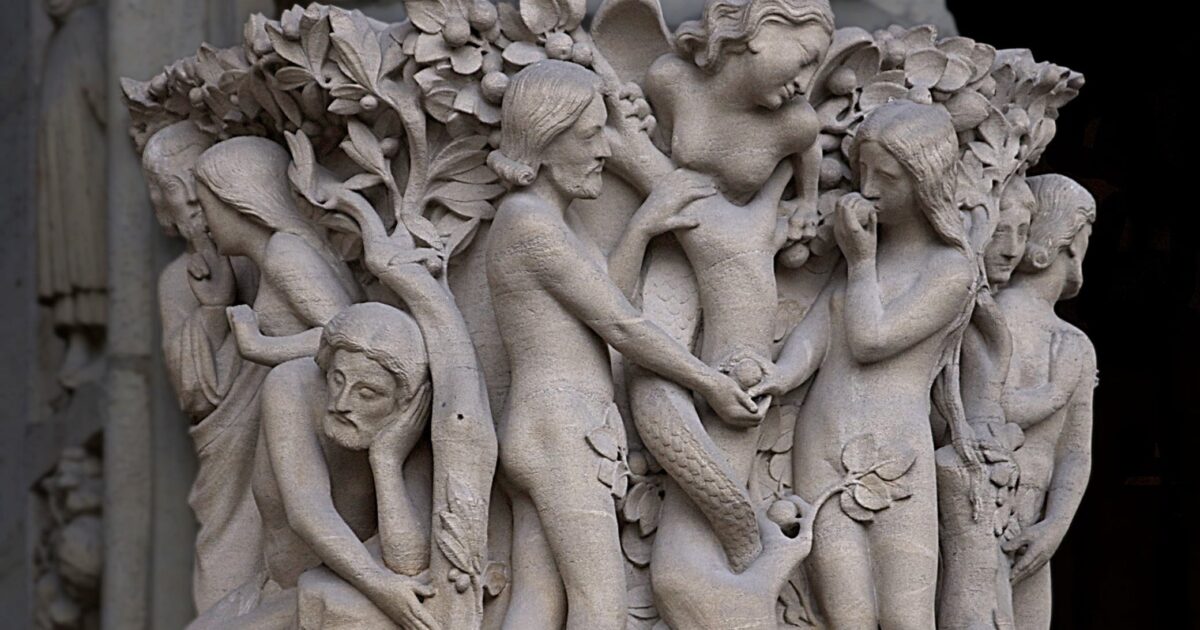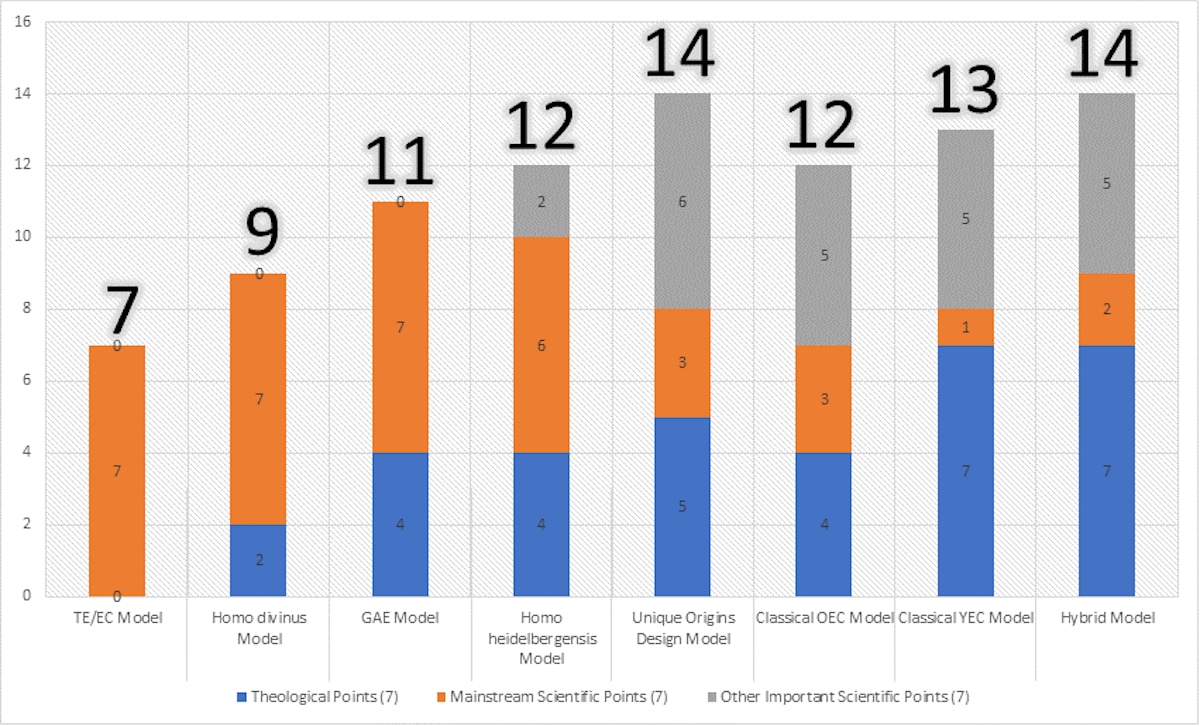 Faith & Science
Faith & Science
 Human Origins
Human Origins
On Human Origins, New Peer-Reviewed Paper Reviews Models for Reconciling Science and Religion

A few months ago I was on a Zoom call with a biochemistry PhD student who attended our Summer Seminar. This young man — we’ll call him Bob — is very bright and favorable to intelligent design. What he said to me over the call was something like this: “Casey, I’m very convinced by the scientific arguments for intelligent design. But the one issue I’m really struggling to make sense of is human origins. There are all these different models out there and I feel a bit overwhelmed. I don’t know exactly what to make of them.”
Like me, Bob is an Evangelical Christian so I could appreciate how he felt: In addition to the classical models of human origins put forth by theistic evolutionists aka evolutionary creationists (TE/ECs), old earth creationists (OECs), and young earth creationists (YECs), in the past few years we’ve seen new models of human origins proposed by Christian scholars and scientists like Joshua Swamidass, William Lane Craig, and various intelligent design (ID) proponents (e.g., Ann Gauger and Ola Hössjer). There are other models out there proposed by other Christians, and it can be a lot for someone to sort through.
A Looming Deadline
Around this same time, I learned of a looming deadline for a special issue on science and faith of the peer-reviewed journal Religions. Prior to this I’d been aware of the special issue, but had given it little thought. After my Zoom session with Bob, I felt there was a need to write a paper comparing and contrasting different models of human origins that have been proposed by Christians.
So, I’m very pleased to announce that the journal has just now published my open-access paper, “Comparing Contemporary Evangelical Models Regarding Human Origins,” which reviews eight models for reconciling science and faith on the topic. Those eight models are:
- The classical theistic evolution or evolutionary creationism model (advocated by folks associated with group BioLogos, and others).
- The Homo divinus model (initially advocated by theologian John Stott and more recently by prominent theistic evolutionist biologist Denis Alexander of the Faraday Institute).
- The genealogical Adam and Eve model (developed by computational biologist and scholar Joshua Swamidass).
- The Homo heidelbergensis model (proposed by philosopher William Lane Craig).
- The unique origins design model (developed by two ID proponents — biologist Ann Gauger and mathematician Ola Hossjer).
- The classical old earth creationist model (advocated by scientists including chemist Fazale Rana and astronomer Hugh Ross, both affiliated with Reasons to Believe).
- The classical young earth creationist model (advocated by groups such as the Institute for Creation Research and Answers in Genesis).
- An old earth/recent humans hybrid model (a lesser-known model advocated by only a few scholars).
Not Here to Advocate
Four of the eight models (1 through 4) are what I consider to be “evolutionary models” and four of the eight models (5 through 8) are what I call “non-evolutionary models.” Although I undoubtedly have my biases, the purpose of my paper is not to advocate any particular model. Rather, my purpose is to lay out what each human origins model claims — and then analyze how those claims fit with both the scientific evidence and also with traditional Christian theological beliefs about human origins. My goal is to help people sort through the different claims of each model so they can decide which one best appeals to them.
Almost all of my prior work writing about human origins has been focused on a strictly scientific analysis (for example, see my chapters in the books Science and Faith in Dialogue, and Science and Human Origins, or Theistic Evolution). So this paper represents a new foray for me into theological territory that frankly is outside my expertise. This paper thus went far afield from intelligent design, but it was fun to write because I got to read a lot of new material, theological material in particular, and found that the analysis flowed quite easily.
A Scoring System
In the final section of the paper, I proposed a scoring system to rate the models based upon how they interact with (a) traditional Christian theological beliefs about human origins, (b) mainstream scientific ideas, and (c) “other important scientific” ideas which are well supported by the evidence and credible scientists. In each of the three categories, the models were capable of receiving up to 7 points, so there was a potential for 21 points to be received.
So how did the models fare? Figure 1 in the paper shows the results:

You can see the paper for the precise points they were scored on. Here’s something you might find interesting: I’m not even sure if I like my own scoring system. Thus, I wrote in the paper (these words were in my original draft — not something that reviewers asked me to include):
The value of this scoring method is unclear, as the various theological and scientific points evaluated may not all have equivalent value. The alternative scientific points (Table 3) could also be selected differently.
Nonetheless, the unique origins design model and the hybrid (old earth/young Adam and Eve) model are tied for the highest score. Does this mean you have to adopt one of those two models? Not necessarily. You could view my ranking system as analogous to the U.S. News & World Report rankings of colleges: they’re there to help you think about options, but they don’t necessarily tell you which school is best for you. (In fact some colleges are leaving the U.S. News ranking system, with its limitations in mind.)
Reconciling Science and Christianity
Thus, if you’re trying to reconcile science and Christianity, the model you accept will probably depend upon whether you want to put more weight on mainstream science, traditional theology, other well supported science (that may or may not be “mainstream”), or some combination thereof. Here’s how I frame it in the paper:
Which models a person prefers will likely depend upon whether they find it more important to align with certain traditional theological beliefs (Table 1), mainstream scientific beliefs (Table 2), other scientific beliefs (Table 3), or a combination of various beliefs from any of those broader categories. For example:
- If one cares very little about traditional theological beliefs regarding human origins and is convinced that mainstream evolutionary biology is correct, then the TE/EC model may be appealing.
- Conversely, if one places the highest priority upon traditional theological beliefs about Adam and Eve, then the YEC or Hybrid models may be most attractive.
For those incorporating both theological and scientific considerations into their positions, some of the newly conceived models incorporate multiple traditional theological views about Adam and Eve and also perform fairly well when compared with the scientific evidence. For example:
- If one finds evolutionary science persuasive but desires a form of historical Adam and Eve, then the Homo heidelbergensis, GAE [Genealogical Adam and Eve], or Homo divinus models may be persuasive.
- If one finds evolutionary claims to be scientifically weak but accepts standard dating methods, then the Unique Origins Design or OEC models seem most viable. The Hybrid model is also available to those who accept an old Earth, though it requires rejecting dating methods as regards many hominid fossils.
So which model do I prefer? Well, my hope is that after reading the paper you won’t be able to tell because my paper’s purpose was not to promote one particular model, but rather to help readers evaluate the similarities and differences between models so they can decide which one they think is the strongest. But I’m not afraid to share my own perspective: At present I’m somewhere between the unique origins design model and the classical old earth creationist model. But I also like elements of the Homo heidelbergensis model — without the evolutionary aspects. I see lots of strengths and weaknesses and I would not say that I’m strongly committed to one particular model. Perhaps in the future I’ll solidify my preference more in one particular direction.
What’s My Biggest Hope?
It is that, if you are a person trying to find ways to reconcile science and Christianity, you’ll find this paper helpful. I’ll part with the closing words from the paper:
If recent decades are any indication, new models will likely be constructed in the future that adopt and refine the strongest elements that these current models have to offer. Whatever the final resolution to these questions, it seems clear that a variety of options already exist for Protestant Evangelicals and other Christians seeking to understand human origins and harmonize traditional theological beliefs with the scientific evidence. Although some models appear more successful than others at achieving a reconciliation, one need not jettison traditional beliefs about Adam and Eve in light of the findings of science.
Again, the paper is open-access and you can find it here.
